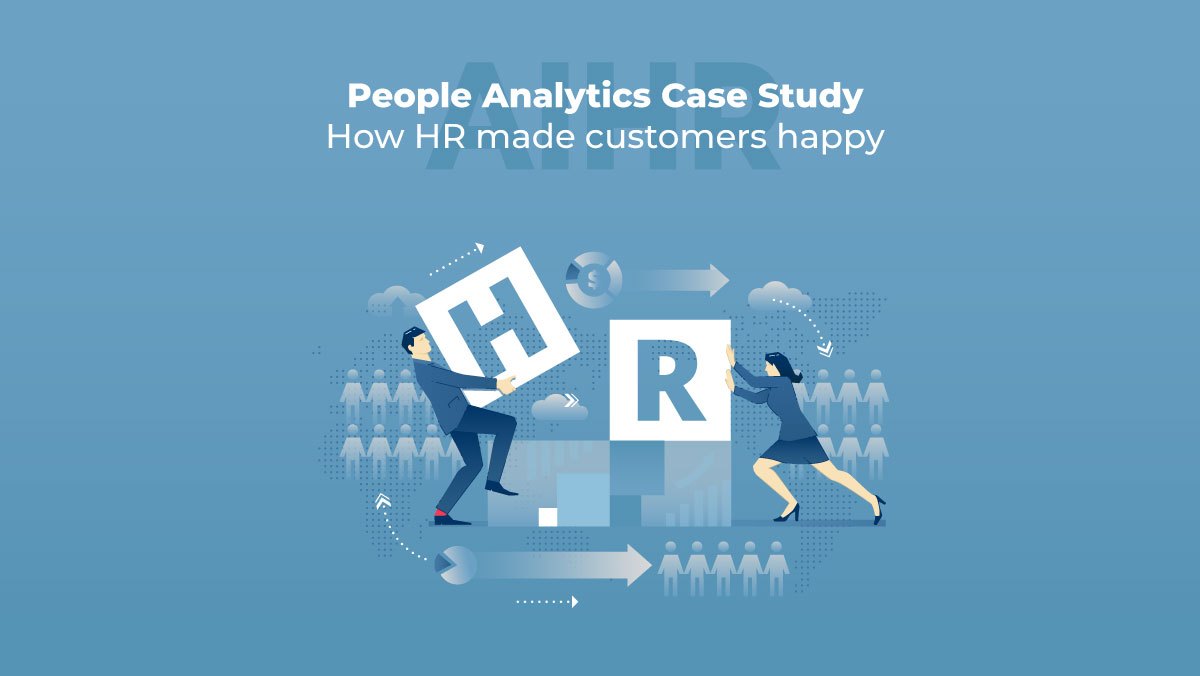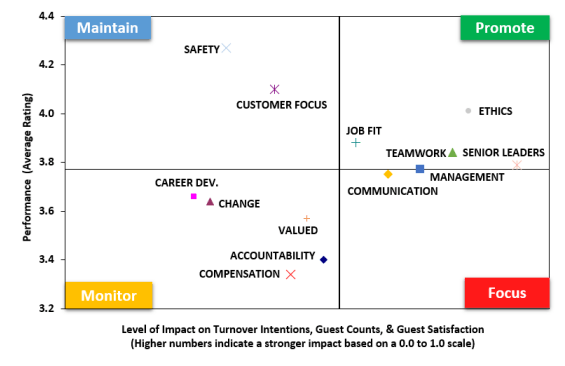People Analytics Case Study: How HR made customers happy

At AIHR we get a lot of requests for case studies to make the analytics process more tangible. In their new book, Predicting Business Success, Scott Mondore and co-authors provided one of the most interesting studies we’ve come across. In this article, they will show how smart people analytics helped to counter a downward trend in a large restaurant chain.
Challenge: Trending in Downward Direction
A large restaurant chain was trending in a downward direction and was struggling to understand why. They had pieces of data, including an annual employee survey, but were not sure where to start to figure out what was going wrong.
When we were asked for help, we first identified three business outcomes that mattered most to the organization by conducting short stakeholder interviews with senior leaders and reviewing their balanced scorecard metrics:
- Customer count (the number of customers eating at the restaurant)
- Customer satisfaction
- Employee turnover
Smartly, the HR leaders started the journey by focusing on these business outcomes—not on the HR process that they were going to implement.
This means that we didn’t focus on employee engagement: These leaders understood that the research that stated employee engagement is a driver of business outcomes is based on questionable methodology and may have damaged HR’s credibility.
While we understand this statement is largely in opposition to popular opinion, we base it on research.
We conducted two studies – 2017 and 2016 – that assessed how often each of the most commonly measured employee attitudes (survey categories) were found to be a statistically significant driver of business outcomes.
Engagement was a driver of business outcomes only 32% and 28% of the time, respectively, underscoring the critical role that employee experiences, not solely engagement, have on organizational performance.
So, instead of focusing on engagement scores, this restaurant chose to make its employee survey truly business-focused by homing in on four areas:
- Link employee attitudes directly to their real business outcomes (e.g. customer count and customer satisfaction)
- Prioritize interventions that would have the greatest impact on their business outcomes
- Focus front-line managers on the areas that would improve their business outcomes
- Show the business impact of improving their key business drivers from the survey
Process: Leveraging Smarter Analytics
A key step in building the analytics process was to align each restaurant’s employee survey data with its respective customer count data, customer satisfaction data, and employee turnover data.
Next, after evaluating their needs, we decided to utilize the most advanced analytics technique, structural equations modeling (SEM), because it allowed us to examine the multiple business outcomes (i.e., customer count, customer satisfaction, and turnover) and predictors (i.e., the annual survey) simultaneously and control for measurement error and other extraneous factors.
Correlational and regression techniques would not have provided the rigor or the capabilities to examine multiple predictors and outcomes at once.
With SEM, we incorporated all the data and identified which employee survey categories linked to the three business outcomes. Our next challenge was to message and relay the results in an impactful way so that leaders would understand what mattered, why it mattered, and what steps to take next.
While there are several effective ways this can be achieved, we use our HeatMaps, depicted in Figure A.
These HeatMaps provide a simple visual display of the complex SEM results to create a clear message for leaders to understand. The HeatMap provides a four-quadrant graphic that pulls a leader’s attention to what matters most and puts it in the Focus box.
In this quadrant, they see the annual survey categories (from employee survey data) that are found to be key drivers of business outcomes (from business performance data—topics on the right side of the HeatMap) and that their workgroup has a low score on (topics on the bottom half of the HeatMap).
If the employee has a low score on one or more of the key drivers of business outcomes, the manager needs to place attention there (multiple categories within the Focus box).
With just one straightforward graphic, managers easily learn where to focus their time, attention, and money to provide the largest ROI. Put simply, the survey categories in the Focus box have the strongest impact on the outcomes of interest to the organization and have the greatest room for improvement.

FIGURE A
Results
Outcome Drivers
For this restaurant chain, the most important drivers of outcomes were Senior Leaders, Teamwork, Management, Communication, Ethics, and Job Fit.
The senior team, in collaboration with HR, created and funded comprehensive initiatives around improving the visibility of senior leaders, the teamwork within and across their restaurants, management development opportunities, a recommitment around ethics and values in the organization and a revamp of their hiring assessment process to improve job fit.

ROI Calculation
We did not stop there though. By identifying the key drivers of customer satisfaction, customer count, and turnover, this large restaurant chain was able to calculate the expected ROI if survey scores increased. By calculating the differences in business outcomes between restaurants that performed well on the key-driver survey categories versus those that scored poorly, we demonstrated the value of scoring higher on the employee survey.
Restaurant managers that had an overall mean rating of 4.00 or greater on the six survey key drivers outperformed their peers. If a manager increased their survey scores on those categories to above a 4.00, they were likely to see a 16 percent increase in customer satisfaction, 18,000 more customers a year, and 10% less staff turnover. With this analysis, HR was able to put a real dollar amount on its strategic initiatives (e.g., recruiting, hiring, surveying) and demonstrate its value to the rest of the business.

The Impact of the Revolving Door
High turnover is clearly an ongoing problem in most retail and restaurant organizations — and the best organizations understand that getting it under control can reduce costs and potentially improve performance. But it isn’t enough to rely on anecdotes and gut-feel.
This organization was able to calculate the stark differences between restaurants that performed well on turnover (or the “revolving door”) versus those that didn’t by comparing actual business data.
As shown in the figure below, the customer counts and customer satisfaction ratings are significantly higher where turnover is more under control. This comparison allows HR to put a real dollar figure on its recruiting, hiring, and turnover initiatives. Business is about making money so there isn’t a compelling reason for why all companies are not doing such calculations.
Conclusion
This organization was able to leverage the power of its people data to most effectively pinpoint where to focus managers at all levels to improve their business outcomes. By using analytics to demonstrate that the resources spent on people initiatives would provide true ROI for the company, these HR leaders were able to serve as true business partners for the company and drive their bottom-line.
HR leaders continue to struggle with demonstrating the worth and/or showing the ROI of the investments companies make in their people. How can HR executives expect the C-suite or business owners to approve of expenditures if the value can’t be clearly depicted with analytics?
Instead, taking a more strategic and business-focused approach to HR initiatives provides benefits to the organization, HR, and even employees by:

Weekly update
Stay up-to-date with the latest news, trends, and resources in HR
Learn more
Related articles
Are you ready for the future of HR?
Learn modern and relevant HR skills, online












